MaryAnn Bernal's Blog, page 28
March 6, 2018
Freyr and Gerd: Lovesick Norse God Seeking Giantess
Ancient Origins
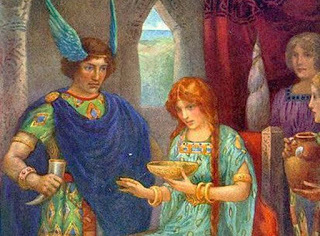
There is a well-known Norse myth which tells of how the Vanir Freyr fell in love with the giantess Gerd, wooed her, and eventually convinced her to marry him. She was not any easy catch - many attempts and various tactics were needed to gain the proud giantess’ hand…
In the Norse religion, Freyr was the son of the Vanir Njord and the twin brother of Freya. According to Norse mythology, Freyr and his father were sent to live with the Æsir as hostages in the peace agreement at the end of the Æsir-Vanir War. Freyr was worshipped as a god of fertility, prosperity, and good harvest. As for Gerd (whose name may be translated from Old Norse as ‘fenced-in’), she is said to be the daughter of Gymir, a little-known jötunn, and Aurboda. Gerd is best-known, however, for being Freyr’s wife.
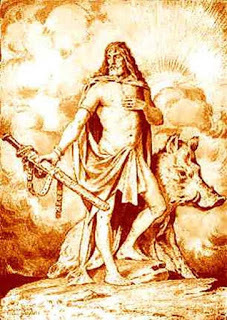
Artwork by Jacques Reich showing the Norse god Freyr and his boar Gullinbursti. ( Public Domain )
A Vanir Falls in Love
The myth of how Freyr fell in love with Gerd can be found in several different literary works. It begins with Freyr sitting on Hlithskjolf (Odin’s throne), where he looked over all the worlds. As he set his eyes on Jötunheimr, the homeland of the jötnar, the god saw a maiden walking towards a house on an estate. According to the Gylfaginning, one of the books in the Prose Edda , as the maiden opened the door of the house, “brightness gleamed from her hands, both over sky and sea, and all the worlds were illumined of her.” Freyr was immediately love-struck and removed himself from Odin’s throne with much sorrow.
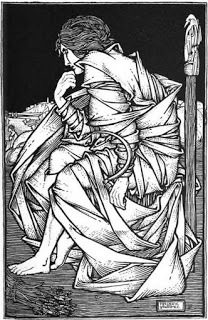
Seated on Odin's throne Hliðskjálf, the god Freyr sits in contemplation. In his hand he holds a sickle and next to the throne sits a sheaf. ( Public Domain )
A Melancholy Norse God
When Freyr returned home, his melancholy was perceived by his father, who bade Skirnir, one of Freyr’s servants, to ask his master what was bothering him. Skirnir did so and found out about Freyr’s dilemma. In the Gylfaginning, the god then sends Skirnir to woo the maiden, promising him a reward for his effort. In the Skirnismol of the Poetic Edda , on the other hand, Skirnir volunteers to woo the maiden for his master.
In both sources, Skirnir requests a horse and a sword from Freyr. Both the horse and the sword that Freyr gives Skirnir are magical objects, as the former could pass through magical flames, whilst the latter would fight on its own, if wielded by a worthy hero.
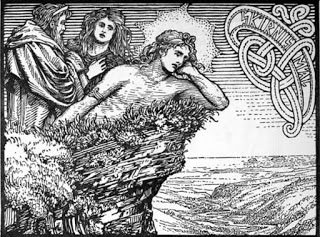
“The Lovesickness of Freyr”, by W.G. Collingwood, 1908. ( Public Domain )
Skirnir eventually arrives at Gymir’s house, where he attempts to woo Gerd. Whilst the version in the Gylfaginning states merely that Skirnir succeeded in his quest, that of the Skirnismol elaborates on how Skirnir managed to accomplish the task. In this version of the myth, Skirnir attempts to purchase Gerd’s love for Freyr with precious gifts, firstly with 11 golden apples, and then with a magic gold ring that belonged to Odin (presumably Draupnir). Gerd refuses the gifts, telling Skirnir that there is enough gold in her father’s house.
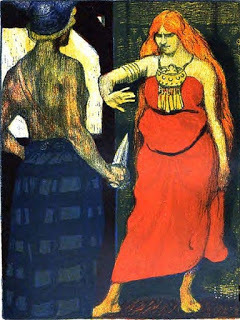
A depiction of the meeting between Skírnir and Gerðr. ( Public Domain )
Seeing that gifts would not persuade Gerd to love Freyr, Skirnir changes his strategy, and resorts to using threats instead. A long list of threats follows, including the promise of using Freyr’s magic sword to slay Gerd and placing various curses on her.
Do Freyr and Gerd Live Happily Ever After?
In the end, Gerd agrees to meet Freyr nine days later in a forest called Barri. Skirnir returns to Freyr with the good news, though the god is impatient, and is not able to wait for nine days. Freyr expresses his anguish with the following, “Long is one night, longer are two; How then shall I bear three? Often to me has a month seemed less than now half a night of desire.” In both the Skirnismol, and the Gylfaginning, the story comes to an abrupt end. It is generally accepted that after the nine tortuous days for Freyr, he meets Gerd meet in Barri and the two become husband and wife.
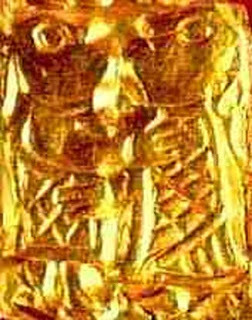
A guldgubbe , an amulet of gold from the iron age, found by Kongsvik, Nordland, Norway in 1747. It is thought to depict the Norse deities Frey and Gerðr. ( Public Domain )
Top image: Skyrnir and Gerda - Illustration by Harry George Theaker (1920). Source: Public Domain
By: Wu Mingren
Published on March 06, 2018 23:30
March 5, 2018
The Great Heathen Army: Viking Coalition Becomes an Anglo-Saxon Nightmare
Ancient Origins
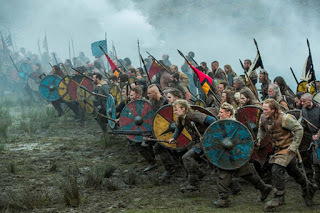
Viking raids may have been a common factor in the life of a 9th century Anglo Saxon, but there was something terrifyingly distinct when an army emerged seeking revenge.
The Great Heathen Army would do whatever it took to see the Anglo Saxons fall. The Great Heathen Army (known also as the Great Viking Army, or the Great Danish Army) is the name given by the Anglo-Saxons to a coalition of Viking warriors that invaded England during the 9th century AD. The main source of information regarding the Great Heathen Army comes from the Anglo-Saxon Chronicle, which is a collection of Old English annals chronicling the history of the Anglo-Saxons. Some information about this army is also in an Old Norse saga known as the Tale of Ragnar’s Sons. Furthermore, archaeology has helped to shed some light on this Viking coalition. Nevertheless, there are many more questions about the Great Heathen Army that have yet to be answered.
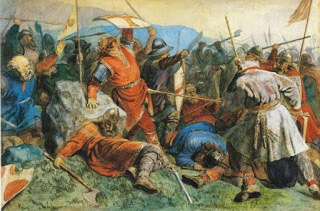
Viking army in battle. (Public Domain)
Accounts of the Great Heathen Army
According to the Anglo-Saxon Chronicle, the Great Heathen Army landed in 866 AD in East Anglia, “A.D. 866. …; and the same year came a large heathen army into England, and fixed their winter-quarters in East-Anglia,” During this time, England was divided between four petty kingdoms – East Anglia, Mercia, Northumbria, and Wessex. Faced with such a fragmented foe, the Great Heathen Army was quite successful in their campaigns and succeeded in overrunning much of the country.
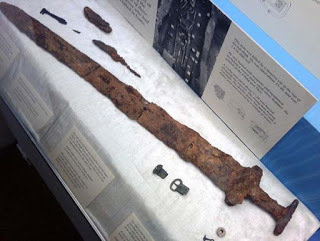
Derby Museum Viking Sword found in Repton. (Roger/CC BY SA 2.0)
The chronicle does not mention the reason for this invasion, perhaps due to the fact that Viking raids were fairly common during that period of time. The Tale of Ragnar’s Sons, on the other hand, mentions that the invasion of England by the Great Heathen Army was aimed at avenging the death of Ragnar Lodbrok, a legendary Viking ruler of Sweden and Denmark. In the Viking saga, Ragnar is said to have conducted a raid on Northumbria during the reign of King Ælla. The Vikings, however, were defeated, and Ragnar was captured by the Northumbrians. Ælla then had Ragnar executed by throwing him into a pit of poisonous snakes. When the sons of Ragnar received news of their father’s death, they decided to avenge him.

Depiction of Ælla of Northumbria's murder on Ragnar Lodbrok (1830) by Hugo Hamilton. (Public Domain)
As is already evident, the military campaign against the Anglo-Saxon kingdoms by the Great Heathen army is treated differently by the Anglo-Saxon Chronicle and the Tale of Ragnar’s Sons, and this difference continues as the story does. In the latter, for instance, much focus in placed on Ivar the Boneless, one of Ragnar’s sons. According to the saga, Ivar founded the town of Jórvík, today known as York, and by forming alliances with the neighboring Anglo-Saxons, built up his military strength. Eventually, Ivar invited his brothers to join him in his attack on Ælla. The Northumbrian king was defeated, and the blood eagle was carved from him. Ivar went on to rule over Northumbria until his death.

Ivar the Boneless as portrayed in the History Channel Series ‘Vikings.’ ( History Channel )
A different story is told in the Anglo-Saxon Chronicle. For instance, the chronicle makes no mention of Ælla’s execution by the blood eagle. Instead, he is recorded to have fallen in a battle against the Great Heathen Army at York. Additionally, tis work focuses on the actions of the Great Heathen Army in a chronological order. For example, in 868 AD, the Great Heathen Army attacked Mercia, and the king sought aid from Wessex to defend his kingdom. The Anglo-Saxon coalition besieged the Vikings in Nottingham. As there was no clear victor, however, the Mercians decided to make peace with the Vikings. In the following year, the Great Heathen Army is recorded to have returned to Jórvík and rested for a year.

King Ælla as he is portrayed in the television series ‘Vikings.’ (CC BY SA)
Questions Remain on the Great Heathen Army
In spite of the available written sources, there are numerous questions about the Great Heathen Army that are still left unanswered. For instance, neither the Anglo-Saxon Chronicle nor the Tale of Ragnar’s Sons mentions the size of the Great Heathen Army. The goal of this army is also another question open to debate. Although the Tale of Ragnar’s Sons provides the reason for the invasion of England, the Anglo-Saxon Chronicle does not. Instead, it seems to be treated as another Viking raid, albeit one that was on a much larger scale than usual
Archaeology has been able to shed some light on the mysterious Great Heathen Army. For instance, a 2016 article published in The Antiquaries Journal presents the results of a project concerning the Great Heathen Army. This project revealed the location, extent, and character of the Great Heathen Army’s winter camp at Torksey, Lincolnshire (872/873 AD).
Additionally, it was reported recently that a mass grave from Derbyshire may contain the remains of some of the warriors in the Great Heathen Army. Such archaeological research has the potential to provide valuable information about the Great Heathen Army and may complement the already available written records.

Battered and broken bodies of Viking warriors unearthed in Derbyshire, England, now identified as soldiers of the Viking Great Army. (Martin Biddle / University of Bristol )
Top image: The Great Heathen Army. Source: CC BY SA
By Wu Mingren

Viking raids may have been a common factor in the life of a 9th century Anglo Saxon, but there was something terrifyingly distinct when an army emerged seeking revenge.
The Great Heathen Army would do whatever it took to see the Anglo Saxons fall. The Great Heathen Army (known also as the Great Viking Army, or the Great Danish Army) is the name given by the Anglo-Saxons to a coalition of Viking warriors that invaded England during the 9th century AD. The main source of information regarding the Great Heathen Army comes from the Anglo-Saxon Chronicle, which is a collection of Old English annals chronicling the history of the Anglo-Saxons. Some information about this army is also in an Old Norse saga known as the Tale of Ragnar’s Sons. Furthermore, archaeology has helped to shed some light on this Viking coalition. Nevertheless, there are many more questions about the Great Heathen Army that have yet to be answered.

Viking army in battle. (Public Domain)
Accounts of the Great Heathen Army
According to the Anglo-Saxon Chronicle, the Great Heathen Army landed in 866 AD in East Anglia, “A.D. 866. …; and the same year came a large heathen army into England, and fixed their winter-quarters in East-Anglia,” During this time, England was divided between four petty kingdoms – East Anglia, Mercia, Northumbria, and Wessex. Faced with such a fragmented foe, the Great Heathen Army was quite successful in their campaigns and succeeded in overrunning much of the country.

Derby Museum Viking Sword found in Repton. (Roger/CC BY SA 2.0)
The chronicle does not mention the reason for this invasion, perhaps due to the fact that Viking raids were fairly common during that period of time. The Tale of Ragnar’s Sons, on the other hand, mentions that the invasion of England by the Great Heathen Army was aimed at avenging the death of Ragnar Lodbrok, a legendary Viking ruler of Sweden and Denmark. In the Viking saga, Ragnar is said to have conducted a raid on Northumbria during the reign of King Ælla. The Vikings, however, were defeated, and Ragnar was captured by the Northumbrians. Ælla then had Ragnar executed by throwing him into a pit of poisonous snakes. When the sons of Ragnar received news of their father’s death, they decided to avenge him.

Depiction of Ælla of Northumbria's murder on Ragnar Lodbrok (1830) by Hugo Hamilton. (Public Domain)
As is already evident, the military campaign against the Anglo-Saxon kingdoms by the Great Heathen army is treated differently by the Anglo-Saxon Chronicle and the Tale of Ragnar’s Sons, and this difference continues as the story does. In the latter, for instance, much focus in placed on Ivar the Boneless, one of Ragnar’s sons. According to the saga, Ivar founded the town of Jórvík, today known as York, and by forming alliances with the neighboring Anglo-Saxons, built up his military strength. Eventually, Ivar invited his brothers to join him in his attack on Ælla. The Northumbrian king was defeated, and the blood eagle was carved from him. Ivar went on to rule over Northumbria until his death.

Ivar the Boneless as portrayed in the History Channel Series ‘Vikings.’ ( History Channel )
A different story is told in the Anglo-Saxon Chronicle. For instance, the chronicle makes no mention of Ælla’s execution by the blood eagle. Instead, he is recorded to have fallen in a battle against the Great Heathen Army at York. Additionally, tis work focuses on the actions of the Great Heathen Army in a chronological order. For example, in 868 AD, the Great Heathen Army attacked Mercia, and the king sought aid from Wessex to defend his kingdom. The Anglo-Saxon coalition besieged the Vikings in Nottingham. As there was no clear victor, however, the Mercians decided to make peace with the Vikings. In the following year, the Great Heathen Army is recorded to have returned to Jórvík and rested for a year.

King Ælla as he is portrayed in the television series ‘Vikings.’ (CC BY SA)
Questions Remain on the Great Heathen Army
In spite of the available written sources, there are numerous questions about the Great Heathen Army that are still left unanswered. For instance, neither the Anglo-Saxon Chronicle nor the Tale of Ragnar’s Sons mentions the size of the Great Heathen Army. The goal of this army is also another question open to debate. Although the Tale of Ragnar’s Sons provides the reason for the invasion of England, the Anglo-Saxon Chronicle does not. Instead, it seems to be treated as another Viking raid, albeit one that was on a much larger scale than usual
Archaeology has been able to shed some light on the mysterious Great Heathen Army. For instance, a 2016 article published in The Antiquaries Journal presents the results of a project concerning the Great Heathen Army. This project revealed the location, extent, and character of the Great Heathen Army’s winter camp at Torksey, Lincolnshire (872/873 AD).
Additionally, it was reported recently that a mass grave from Derbyshire may contain the remains of some of the warriors in the Great Heathen Army. Such archaeological research has the potential to provide valuable information about the Great Heathen Army and may complement the already available written records.

Battered and broken bodies of Viking warriors unearthed in Derbyshire, England, now identified as soldiers of the Viking Great Army. (Martin Biddle / University of Bristol )
Top image: The Great Heathen Army. Source: CC BY SA
By Wu Mingren
Published on March 05, 2018 23:00
March 4, 2018
Medieval zombies: how the walking dead haunted the Middle Ages
History Extra

Until the Enlightenment, even the most learned agreed that the dead could rise from their graves. Darren Oldridge, the author of a book on seemingly 'strange' ideas from the past, explores the origins of the belief
The corpse would not be still. It thrashed and groaned when the executioner tried to subdue it, and foam spilled from its mouth. The dead man was eventually dumped in a grave and covered with earth; but he still made “such a rumbling and tumbling in it, that the very earth was raised, and the mules were so heaved up that they could hardly keep them down”.
George Sinclair told this story in 1684. Seven years later, he became professor of mathematics at Glasgow University. He did not present his tale as an instance of peasant superstition, nor misdiagnosed death. He believed the corpse had returned to life. He noted that the account came “from a very creditable person, who being a scholar there at that time, was an eye and ear witness, who is yet alive”. Sinclair’s acceptance of such events placed him in the mainstream of European thinking. He shared his belief in the existence of “revenants”, or revitalised cadavers, with James VI and I, King of Scotland, England and Ireland as well as the esteemed Cambridge philosopher, Henry More. More wrote in 1655 that he could not “so much as imagine” how anyone could doubt the existence of these creatures, so convincing were the reports about them.
Earlier authors provided numerous accounts of the wakeful dead. Around 1170, William of Newburgh described how a roaming corpse tormented the residents of Melrose Abbey. A priest stabbed the creature and drove it back to its tomb. The German monk Caesarius of Heisterbach recorded similar tales in the 13th century. One concerned a knight who “appeared to many” after death: “He was often struck with a sword but could not be wounded, giving off the sound of a soft bed being struck”. The Bishop of Trèves eventually exorcised the creature. In the late Middle Ages, the revival of corpses was often linked to witchcraft; and Renaissance demonologists such as Martín del Rio noted that Satan could revive the dead to consort with earthly followers.
Why did educated people believe these things? The simple answer is that they had no strong reason not to. The origins of particular “eye witness” accounts will always remain obscure, but once they were in circulation, and ascribed to suitably reliable sources, nothing in the stories themselves was incredible. It was not that scientists like George Sinclair regarded tales of revenants as unremarkable: indeed, they reported them precisely because they were striking instances of the supernatural. Nonetheless, such events were consistent with the knowledge of the world shared by virtually all educated westerners in medieval and Renaissance Europe.
Three broad assumptions lent credibility to the returning dead. First of all, the idea of physical resurrection was central to Christianity. The gospels described Jesus’s resurrection of Lazarus and the daughter of Jairus, and Christ himself rose from the tomb. More generally, all Christians would leave their graves at the Last Judgment. As artists like Giotto and Signorelli made plain, this would be a physical experience: the awakening dead would uncoil their bodies and stretch their limbs, and the torments of the damned would be excruciatingly real. Bodily resurrection was an established fact. It was natural, therefore, for pre-modern scholars to take the phenomenon seriously.
Secondly, most medieval and Renaissance people assumed that the ties between this life and the next were not severed completely at death. Spirits could return to complete business left unfinished on earth. The dead sometimes returned physically to remind sinners of what awaited them in hell. In a frightful episode from 12th-century France, the body of a dead student appeared at his friend’s bedside to show him the pains he could expect if he continued his debauched life. The visitor flicked three drops of sulphurous pus into his friend’s face, “so that they pierced his skin and flesh like cauterising fire and made a hole the size of a walnut”. He changed his ways.
When Protestants abolished the doctrine of purgatory in the 16th century, they challenged traditional ideas about the traffic between living and dead. This meant sightings of ghosts were often dismissed as hoaxes or illusions in regions affected by the Reformation, though Catholic authorities were generally more sympathetic. Stories of revenants remained plausible, however, because of the third general assumption that lent credibility to the phenomenon: the existence of demons.
As well as describing the miracles of God, the New Testament provided copious evidence of the power and intentions of Satan. The gospels recorded his ability to enter human bodies and the soulless flesh of animals. For medieval and Renaissance scholars, this facility offered a simple explanation for reports of reanimated corpses: demons possessed and moved them like puppets, without truly rejoining the spirit to the body. Such “fake resurrections” also confirmed the Devil’s desire to ape the miracles of God. It was one consequence of this belief that learned descriptions of revenants stressed the lifelessness of their bodies, which were little more than playthings for the unclean spirits within. Their flesh remained pale, rank and cold, noted Martín del Rio in 1600. Others recorded how revenants collapsed into dust once demons departed. In 1751, the Benedictine Abbot Augustine Calmet described the false resurrection of a young boy: “the demon that had animated him quitted him with a great noise; the youth fell backwards, and his body – which was fetid and stank unsupportably – was dragged with a hook… and buried in a field without any ceremony”.
The involvement of demons explains why Renaissance thinkers associated the revival of the dead with witchcraft. As disembodied spirits, demons needed fake bodies to make physical contact with humans. Following St Augustine, most writers assumed that they normally crafted these bodies from air: possessed corpses provided a gruesome alternative. As “they are foul and unclean spirits”, Nicholas Rémy suggested in 1595, they “find their favourite habitation… in stinking corpses”. A few years later, Henri Boguet confirmed that Satan has “sometimes borrowed the body of a man who has been hanged, and this he does chiefly when he wishes to associate with a witch”.
Since revenants demonstrated the activity of demons, they supported the wider belief in an “invisible world” of spirits. When natural science began to challenge this belief in the late 17th century, those who wished to preserve traditional religion used tales of the returning dead to prove the existence of this other realm. This was George Sinclair’s purpose in 1684. In the words of Henry More, belief in revenants was “an antidote to atheism”. This rearguard action was ultimately unsuccessful. Enlightenment scientists banished the invisible world of demons to the realm of “superstition”. It is one measure of their achievement that revived corpses now belong exclusively to fiction: they are simply incredible in the “real world”. But for orthodox Christians from the Middle Ages to the 1700s, it was equally absurd to believe that the dead could never stir.
Dr Darren Oldridge, a senior lecturer in history at the University of Worcester, has published extensively on early modern religion and witchcraft. His latest book is Strange Histories (Routledge, 2005)

Until the Enlightenment, even the most learned agreed that the dead could rise from their graves. Darren Oldridge, the author of a book on seemingly 'strange' ideas from the past, explores the origins of the belief
The corpse would not be still. It thrashed and groaned when the executioner tried to subdue it, and foam spilled from its mouth. The dead man was eventually dumped in a grave and covered with earth; but he still made “such a rumbling and tumbling in it, that the very earth was raised, and the mules were so heaved up that they could hardly keep them down”.
George Sinclair told this story in 1684. Seven years later, he became professor of mathematics at Glasgow University. He did not present his tale as an instance of peasant superstition, nor misdiagnosed death. He believed the corpse had returned to life. He noted that the account came “from a very creditable person, who being a scholar there at that time, was an eye and ear witness, who is yet alive”. Sinclair’s acceptance of such events placed him in the mainstream of European thinking. He shared his belief in the existence of “revenants”, or revitalised cadavers, with James VI and I, King of Scotland, England and Ireland as well as the esteemed Cambridge philosopher, Henry More. More wrote in 1655 that he could not “so much as imagine” how anyone could doubt the existence of these creatures, so convincing were the reports about them.
Earlier authors provided numerous accounts of the wakeful dead. Around 1170, William of Newburgh described how a roaming corpse tormented the residents of Melrose Abbey. A priest stabbed the creature and drove it back to its tomb. The German monk Caesarius of Heisterbach recorded similar tales in the 13th century. One concerned a knight who “appeared to many” after death: “He was often struck with a sword but could not be wounded, giving off the sound of a soft bed being struck”. The Bishop of Trèves eventually exorcised the creature. In the late Middle Ages, the revival of corpses was often linked to witchcraft; and Renaissance demonologists such as Martín del Rio noted that Satan could revive the dead to consort with earthly followers.
Why did educated people believe these things? The simple answer is that they had no strong reason not to. The origins of particular “eye witness” accounts will always remain obscure, but once they were in circulation, and ascribed to suitably reliable sources, nothing in the stories themselves was incredible. It was not that scientists like George Sinclair regarded tales of revenants as unremarkable: indeed, they reported them precisely because they were striking instances of the supernatural. Nonetheless, such events were consistent with the knowledge of the world shared by virtually all educated westerners in medieval and Renaissance Europe.
Three broad assumptions lent credibility to the returning dead. First of all, the idea of physical resurrection was central to Christianity. The gospels described Jesus’s resurrection of Lazarus and the daughter of Jairus, and Christ himself rose from the tomb. More generally, all Christians would leave their graves at the Last Judgment. As artists like Giotto and Signorelli made plain, this would be a physical experience: the awakening dead would uncoil their bodies and stretch their limbs, and the torments of the damned would be excruciatingly real. Bodily resurrection was an established fact. It was natural, therefore, for pre-modern scholars to take the phenomenon seriously.
Secondly, most medieval and Renaissance people assumed that the ties between this life and the next were not severed completely at death. Spirits could return to complete business left unfinished on earth. The dead sometimes returned physically to remind sinners of what awaited them in hell. In a frightful episode from 12th-century France, the body of a dead student appeared at his friend’s bedside to show him the pains he could expect if he continued his debauched life. The visitor flicked three drops of sulphurous pus into his friend’s face, “so that they pierced his skin and flesh like cauterising fire and made a hole the size of a walnut”. He changed his ways.
When Protestants abolished the doctrine of purgatory in the 16th century, they challenged traditional ideas about the traffic between living and dead. This meant sightings of ghosts were often dismissed as hoaxes or illusions in regions affected by the Reformation, though Catholic authorities were generally more sympathetic. Stories of revenants remained plausible, however, because of the third general assumption that lent credibility to the phenomenon: the existence of demons.
As well as describing the miracles of God, the New Testament provided copious evidence of the power and intentions of Satan. The gospels recorded his ability to enter human bodies and the soulless flesh of animals. For medieval and Renaissance scholars, this facility offered a simple explanation for reports of reanimated corpses: demons possessed and moved them like puppets, without truly rejoining the spirit to the body. Such “fake resurrections” also confirmed the Devil’s desire to ape the miracles of God. It was one consequence of this belief that learned descriptions of revenants stressed the lifelessness of their bodies, which were little more than playthings for the unclean spirits within. Their flesh remained pale, rank and cold, noted Martín del Rio in 1600. Others recorded how revenants collapsed into dust once demons departed. In 1751, the Benedictine Abbot Augustine Calmet described the false resurrection of a young boy: “the demon that had animated him quitted him with a great noise; the youth fell backwards, and his body – which was fetid and stank unsupportably – was dragged with a hook… and buried in a field without any ceremony”.
The involvement of demons explains why Renaissance thinkers associated the revival of the dead with witchcraft. As disembodied spirits, demons needed fake bodies to make physical contact with humans. Following St Augustine, most writers assumed that they normally crafted these bodies from air: possessed corpses provided a gruesome alternative. As “they are foul and unclean spirits”, Nicholas Rémy suggested in 1595, they “find their favourite habitation… in stinking corpses”. A few years later, Henri Boguet confirmed that Satan has “sometimes borrowed the body of a man who has been hanged, and this he does chiefly when he wishes to associate with a witch”.
Since revenants demonstrated the activity of demons, they supported the wider belief in an “invisible world” of spirits. When natural science began to challenge this belief in the late 17th century, those who wished to preserve traditional religion used tales of the returning dead to prove the existence of this other realm. This was George Sinclair’s purpose in 1684. In the words of Henry More, belief in revenants was “an antidote to atheism”. This rearguard action was ultimately unsuccessful. Enlightenment scientists banished the invisible world of demons to the realm of “superstition”. It is one measure of their achievement that revived corpses now belong exclusively to fiction: they are simply incredible in the “real world”. But for orthodox Christians from the Middle Ages to the 1700s, it was equally absurd to believe that the dead could never stir.
Dr Darren Oldridge, a senior lecturer in history at the University of Worcester, has published extensively on early modern religion and witchcraft. His latest book is Strange Histories (Routledge, 2005)
Published on March 04, 2018 23:00
Read an Ebook Week 2018 Smashwords Sale from March 4 - 10.

Author Mary Ann Bernal is participating in the Read an Ebook Week Smashwords Sale from March 4 - 10, 2018. All her novels and short story collections are available at either a reduced price or are free. Why not stop by her profile page and have a look? Click here to find all of Mary Ann Bernal's works.
The Story Behind ‘Read an eBook Week’
By Mark Coker
Blog post originally published 2010, updated 2017
For one week each year, Rita Toews, 61, a soft-spoken mother of two and grandmother of one, sits at the center of the ebook universe.

Operating from a spare bedroom in her home in Winnipeg, Manitoba, Canada with her cat Lola by her side (“Every author needs a cat,” she says), Ms. Toews is the creator and chief ringmaster of Read an Ebook Week, an annual international celebration of ebooks that kicks off its seventh season this Sunday March 7.
Read an Ebook Week brings together ebook retailers, publishers, authors, device-makers and untold thousands of readers who join in this international literary event of ebook discovery, and yes, gluttony.
For the one week only, publishers and authors offer thousands of original ebooks for free and at deep discounts to encourage book lovers around the globe to give ebooks a try.
Ms. Toews, with her website at ebookweek.com, acts as a centralized clearinghouse to help readers locate participating authors and retailers. By harnessing the collective promotional power of thousands of enthusiastic authors and readers who funnel traffic through Ms. Toews’ web site, participating authors, publishers and retailers see large spikes in traffic and downloads during the week.
To read the interview in its entirety, click here.

Published on March 04, 2018 00:30
Medieval Ring Unearthed in the Shadow of Armageddon
Ancient Origins

A rare 700-year-old bronze ring bearing a tiny image of Saint Nicholas, patron saint of pilgrims and travelers, was dug up in a routine weeding exercise in northern Israel.
Gardener Dekel Ben-Shitrit who discovered the ancient artifact told reporters at Haaratz “I rubbed it slightly and I saw it was carved with a human image inside a frame.” As to how it got here, specialists suspect that it was “dropped by a medieval-era pilgrim making his or way to the Galilee in Israel’s north.”
Ben-Shitrit’s neighbor in a kibbutz in northern Israel, Dror Ben-Yosef, is the director of the Israel Nature and Parks Authority’s Lower Galilee Education Center, and the Haaratz report said that as soon as he saw the ring he knew it was rare and valuable so “he put Ben-Shitrit in touch with the Israel Antiquities Authority.”

Gardener Dekel Ben-Shitrit with the ring he found while weeding. (Nir Distelfeld, Israel Antiquities Authority)
The ring was dated to between the Crusader and Mameluke periods — from the 12th to the 15 centuries and IAA archaeologist Yana Tchekhanovetz, who specializes in the Byzantine period, told reporters at Times of Israel “it was amazingly well preserved and will contribute a great deal to science.”
The ring is decorated with a smiling bald man holding a bishop’s crook, which specialists identified as being hallmarks of St. Nicholas. Tchekhanovetz told reporters “It is probable that the ring belonged to a pilgrim who sought the protection of St. Nicholas on his travels.” In Eastern Christianity, St. Nicholas was considered the patron saint of travel, including of pilgrims and sailors and in Western Christianity, the “compassionate and giving” St Nicholas world turn into Santa Claus.
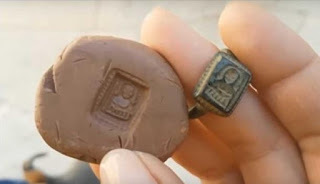
Gardener Dekel Ben-Shitrit with the ring he found while weeding. (Nir Distelfeld, Israel Antiquities Authority)
The ring was dated to between the Crusader and Mameluke periods — from the 12th to the 15 centuries and IAA archaeologist Yana Tchekhanovetz, who specializes in the Byzantine period, told reporters at Times of Israel “it was amazingly well preserved and will contribute a great deal to science.” The ring is decorated with a smiling bald man holding a bishop’s crook, which specialists identified as being hallmarks of St. Nicholas. Tchekhanovetz told reporters “It is probable that the ring belonged to a pilgrim who sought the protection of St. Nicholas on his travels.” In Eastern Christianity, St. Nicholas was considered the patron saint of travel, including of pilgrims and sailors and in Western Christianity, the “compassionate and giving” St Nicholas world turn into Santa Claus.
Armageddon
You must be asking yourself by this stage, what on earth this all has to do with “the Shadow of Armageddon” in the headline? Well, only 6 miles from where Ben-Shitrit dug up the ring is a very ancient place of immense historic, geographic and theologic importance - Tel Migiddo. Excavations have unearthed 26 layers of ruins, indicating an extremely long period of settlement and this was a very important Canaanite city-state during the Bronze Age, and during the Iron Age it was a royal city in the Kingdom of Israel.
Strategically located at the northern end of the Wadi Ara defile, overlooking the rich Jezreel Valley to the west and guarding the pass through the Carmel Ridge, Megiddo was known to Greeks as “Armageddon.” Even today, many Christians believe this site to be where the final battle between Jesus Christ and the kings of the Earth who go to war against Israel, as outlined in the Book of Revelation, will occur.
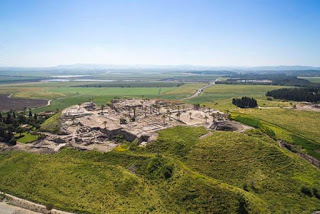
Megiddo, or Tel Megiddo, is the site of an ancient city in northern Israel's Jezreel Valley. (CC BY-SA 2.0)
There is no arguing Ben-Shitrit’s chance discovery of the 700-year old bronze ring is of great archaeological value, but this is not the first ancient ring to be unearthed in these parts. In 2012 Israel International News reported that “Archaeologists have discovered a collection of ancient jewelry hidden in a vessel at Tel Megiddo dated from about 1100 BCE, and one of the pieces is an ornate gold ring “without parallel,” according to Tel Aviv University's Professor Israel Finkelstein. Some of this jewelry originated in Egypt and the hoard also included “a number of moon-shaped earrings of common Canaanite origin, as well as many gold items and a number of carnelian beads, common in Egyptian jewelry of the period.”
In an area that has seen so many invasions and wars I suppose it of little surprise that we find so much jewelry buried just beneath the top soil in this region. Seeing the horizon darkened with the spears of 10 thousand of “the other side” seems to have inspired people to quickly bury their valuables beneath their floors in the dream that they might one day return home. One thing was a certainty, if they were captured, the ring would be lost forever.
For his lucky archaeological discovery, and being honest enough to come forward with it, Ben-Shitrit will receive the gift of an IAA good citizenship certificate, according to a Times of Israel report.
Top image: The ring found by gardener Dekel Ben-Shitrit thought to depict St. Nicholas with a bishop's crook. Source: Clara Amit, Israel Antiquities Authority
By Ashley Cowie
Published on March 04, 2018 00:00
March 2, 2018
Magic into Myth: Avalon, Mystical Isle of Medieval Arthurian Literature
Ancient Origins

The Isle of Apples, Isle of the Blessed, and the Otherworld. These titles have long been associated with the magical resting place of the early medieval king, Arthur Pendragon. A realm imbued with magic, mystery and mysticism, Avalon is as much a metaphor as a true metaphysical realm.
Its existence and the essence of Avalon had therefore varied from author to author. What was Avalon's role in medieval literature, then? Was it magical or metaphorical? Was it both? Was it entirely unrelated to Arthur? Well, the last question is evidently answered with a resounding "NO"; but is there a question about Avalon that can be answered with a resounding "yes"? This work will examine the ways in which Avalon was depicted in medieval literature, how it was altered over time, and some of the literary and historical implications of the site's supposed mysticism.

An artist’s interpretation of Avalon. (Iribel/Deviant Art)
Avalon is Discussed More than Visited
Avalon has long been a staple of the literature of King Arthur and the Knights of the Round Table. From it stems the majority of the magic that encompasses fairy-tale-esque retellings, and the pagan roots of the British world prior to the rise of Christianity under King Arthur’s reign.
In Avalon, the dreaded Morgan le Fay was taught the magic of the ancients, eventually using this magic to bring about the fall of King Arthur and his royal court. The precise name of the enchantress, and her role in Arthur’s story varies between retellings, but the roots of the dark sorceress who influences the court remains the relatively the same. Similarly, magic vs. sword and pagan vs. Christian have been used interchangeably as metaphors.

Morgan le Fay learned ancient magic on Avalon. (Manzanedo/Deviant Art)
Within medieval literature, Avalon appears to be discussed about more than it is seen. It is best remembered as Arthur’s eternal resting place. Literature discusses Avalon as the place from which magic stems, as a realm behind the veil of mists that encompasses the titular lake of the Lady of the Lake.
From Avalon, passed on by the Lady, comes the infamous sword Excalibur, and the intention behind its mystical/pagan origins is not only that it signifies Arthur as the “once and future king”, but also that Arthur has innately been tied to the world of Avalon. The Lady of the Lake, often portrayed as Lancelot’s mother and occasionally Merlin’s lover, has long alternated between being independent of Morgan le Fay and part of her. That is, the roles of the two are as often intertwined—one could even argue they are confused—as not.
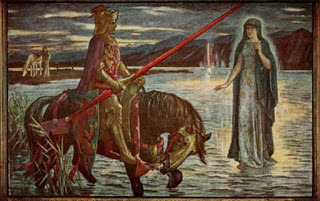
Illustration by H.J. Ford for Andrew Lang's Tales of Romance, 1919. "Arthur meets the Lady of the Lake and gets the Sword Excalibur." (Public Domain)
Intertwining Arthur and Avalon
The primary medieval source of the myth of King Arthur comes from Geoffrey of Monmouth, 10th-11th century AD. Geoffrey’s Historia Regum Britanniae appears to have been utilized throughout the medieval period as an initial source for Arthurian legends. Portraying Arthur and his story in a historical fashion, Geoffrey’s history indicates that there likely was a historical Arthur, the details of which have always been scarce.
As such, the tales of Arthur and his knights have varied throughout the centuries, dependent upon the cultural perceptions and perspectives of the era. For example, the French writer Chrétien de Troyes (c. 12th century) emphasizes the more romantic aspects of being a knight under Arthur, and it is from Chrétien and his contemporaries that “courtly love” stems. 15th century Thomas Malory’s rendition Le Morte’ de Arthur provides a more comprehensive overview of Arthur and the Round Table, building upon Geoffrey's and Chrétien’s stories (among others).

Voyage of King Arthur and Morgan Le Fay to the Isle of Avalon, Frank William Warwick Topham (1838-1924). ( Public Domain )
It is widely believed that Geoffrey first mentioned Avalon as a mythical Otherworld, as well as Morgan le Fay as the island’s leader:
Geoffrey also says that Avalon is where Arthur’s sword, Caliburn [an earlier name of Excalibur], was forged, while the Vita Merlini provides another name for the same locations, the Insula Pomorum or Isle of Apples. The Avalon of the Vita is a utopian place where agriculture is self-sustaining and human life is longer, and is inhabited by nine sisters who are enchantresses (Morgan le Fay is the first of these nine).
Rushton, 215.
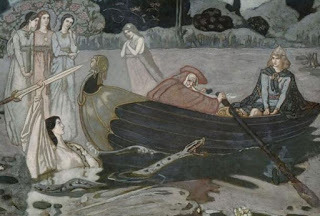
The taking of Excalibur by John Duncan. (Public Domain)
As Rushton states, Geoffrey of Monmouth called the leader of Avalon Morgan le Fay, and in this role she was often depicted as a powerful enchantress with the interests of Arthur and the survival of paganism in mind. (However when Morgan le Fay is blended with Arthur’s half-sister and the mother of his son, Mordred, her intentions are destructive). She has also been called Vivian or Morgaine, Arthur’s half-sister, and, in some instances—as mentioned above—she is occasionally blended with the character of the Lady of the Lake. (Thus, the reasons for her alternating allegiances in the legends.)
It is not Geoffrey, however, but Gerald of Wales who initially indicates that Avalon was the resting place of Arthur’s death. Writing in the 12-13th centuries, Gerald follows Geoffrey’s general depiction of Avalon, yet he asserts that Arthur dies before his body is taken to Avalon. Geoffrey, on the other hand, appears to imply that Arthur continued his life in Avalon after the fall of his kingdom.
While Gerald is not alone in his perception of the myth—as indicated by later writers of the myth such as 19th century Alfred Tennyson—Geoffrey’s viewpoint was more readily accepted in the medieval period and was subsequently borrowed by 13th century author William of Rennes, who “provides an idyllic description of Avalon, and the further detail that Arthur and a “royal maiden” who heals him and live together as a couple.”
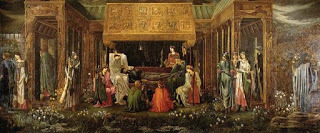
‘The Last Sleep of Arthur in Avalon’ (1881-1898) by Edward Burne-Jones. (Public Domain)
The Debate on Avalon’s Existence
Avalon as a historical place has long been under debate as well. The elusiveness of the understanding of the location in British literature has made it nearly impossible to discern whether there truly was an Avalon or if Geoffrey created it with influences from the native Celtic religion. If Avalon did exist, it is usually attributed to Glastonbury in England, in part due to an island that disappeared sometime before or during the 12th century.
It also fits descriptions of the mythical isle, although—again—it is possible the island was imagined in the image of Glastonbury Tor without the Tor actually being the site. The debate of Avalon’s existence only grew when a pair of rich graves was discovered in Glastonbury near the mythologically-infused Tor, believed to be those of Arthur and his Christian wife Guinevere.

Glastonbury Tor has been linked to Avalon. (R Potticary/ CC BY SA 3.0 )
All in all, it cannot be doubted that Avalon played a powerful role in the expanse of literature surrounding King Arthur and his knights. The time period Arthur likely "lived" might remain hazy (though scholars lean toward the early medieval period of 500-900 AD), but that did not squelch attempts to understand and spread Arthur's historical and mystical tale during the medieval period. That exploration continues to this day, with no particular end in sight.
Yet it appears that the primary purpose Avalon served in medieval literature is to provide divine origins for Arthur's kingship and to connect the worlds of mortals and magic, Christian and pagan, during a tense period of transition.
The stories of Avalon maintain common themes—love, betrayal, and religious dissonance, to put it simply—and all have the same resolution: Arthur spends the last of his days in Avalon, and the pagan world preceding his reign has mostly passed. Therefore, Avalon's lengthy association with magic and old-world religion during the medieval period remains a sensible, though likely metaphorical, assertion.

Artist’s representation of Avalon. (AlexandraVBach/Deviant Art)
Top Image: ‘Avalon finalised.’ Source: cheery-macaroon/Deviant Art
By Riley Winters
Published on March 02, 2018 23:30
March 1, 2018
Do you dare enter a fairy ring? The mythical mushroom portals of the supernatural
Ancient Origins
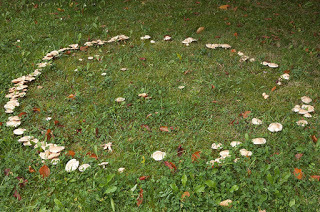
For thousands of years, the sudden appearance of a ring of mushrooms was a sure sign of otherworldly presences. These rings would seemingly appear overnight, or travel from one location to another, with no clear rhyme or reason. Warnings of the dark forces that must create these abnormalities were passed down between generations, and the folklore of fairy rings was established.
These fairy rings (fairy circles, elf circles or pixie rings) are a naturally occurring phenomenon. A fungi creates a ring or arc shape within the soil, affecting the grass in the area, and grows up through the greenery forming a circle of mushrooms. These rings—a lovely surprise and good luck to some, or a dark omen and nasty lawn problem to others—can spread from a very few inches or feet to 164 feet (50 meters) or more. The ring found in Belfort, France, is thought to be the largest ring ever found. It is approximately 2,000 feet (600 meters) in diameter, and an astonishing 700 years old

Fairy rings in moss in Iceland. (Chmee2/Valtameri / CC BY 3.0)
Sometimes there can be more than one ring in an area, and they will overlap, creating strange, winding patterns in the grass. Often the grass inside the ring is dead and withered, and has a clearly different coloring than the grass outside.
Supernatural Creatures with Mysterious Powers
Fairy rings have an historical, mythical reputation, as revealed by the folklore and warnings surrounding them around the globe, but especially in Western Europe.

A mushroom ring in the woods. (Alison Chaiken, Flickr/CC BY-SA 2.0)
Various places have their own superstitions surrounding the fairy rings, but for the most part the myths involve fairies or supernatural creatures either dancing around the ring, or have the ring serving as a portal between the fairy realm and our world. It was also believed that the circles were formed by shooting stars, lightning strikes, or were the work of witches. These beliefs persisted into the 19th century, as did the warnings to not stray into a fairy circle, lest you be transported to the fairy realm, and certain doom.
The rings are known throughout Europe. In tradition, they were called “sorcerers’ rings” in France, and “witches rings” in Germany, where they’re supposedly most active on Walpurgisnacht, the eve of April 30, when witches were believed to meet and hold large celebrations coinciding with the arrival of Spring.

Beautiful fairy ring, or profuse circle of Clitocybe nebularis fungus. (CC BY-SA 3.0)
In English, Scandinavian and Celtic and many other traditional European beliefs the rings were caused by fairies or elves dancing. Such events were associated especially with moonlit nights, and the sudden appearance of the rings in the morning were evidence of a dance the evening before.
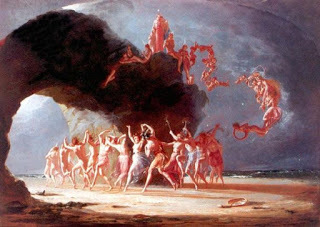
Images of nude and semi-nude fairies dancing in rings became popular during the Victorian era. Public Domain
In Scotland it was believed the fairies sit on the mushrooms and use them as tables for their fetes, while in Wales the story goes that the mushrooms were picked by the fairy folk and used as parasols or umbrellas. Even now in Wales it’s said the rings signify an underground fairy village. Welsh folklore also considers the rings as locations of fertility and fortune, and claim that crops grown around them and livestock feeding nearby will flourish.
In contrast, the Dutch legends had it that the barren center of the ring was caused by the devil placing his milk-churn there.
The Austrian tradition said flying dragons caused the rings, blighting the area so only toadstools could grow there for seven years.
French folklore believed the strange circles were guarded by giant toads that would curse anyone that happened into the ring.
Do NOT Step Into the Ring
It is generally felt that fairy circles are to be avoided as dangerous places as they’re associated with malevolent beings.
If you dare to enter a ring, many myths warn you will die young. You also become invisible to the mortal world, unable to escape the ring, or you are transported instantly to the fairy realm. You might also lose an eye for your foolishness. Either way, you will be forced to dance around the ring until you die of exhaustion or madness.
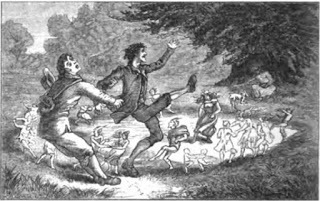
"Plucked from the Fairy Circle" A man saves his friend from the grip of a fairy ring. Public Domain
To avoid this terrible, cavorting fate, you can take specific measures, such as running around the ring nine times (nine times only, as 10 is too many and will undo the procedure). It is said that to enter the ring without penalty you can run around the ring during a full moon, but only in the direction the sun travels during the day. If you do this you might hear the fairies dancing underground.
You might also wear a hat backwards, because this is said to confuse the fairies and they will not do you harm.

This fellow is probably in trouble – his hat is not on backwards. The Fairy Ring; the Enchanted Piper (c.1880) Public Domain
Can Science Explain the Mystery?
In present day the fungi that causes the natural phenomenon is well understood. Mycelium is a spreading fungus which grows in fertile, damp environments. In good conditions, the spores will develop into mushrooms (the most well-known being the edible Scotch bonnet, or fairy ring champignon). The mushrooms reach out of the ground and create an easily visible ring. Underground, the mycelium networks out under the grass, moving outward from the center, and feeding upon organic matter and decomposing as it travels. The dead mycelium forms a thick, water-repellant mat that starves the grass roots of nutrients and moisture. Eventually the land within the ring withers and dies from starvation, but the leading edge of the ring remains lush and green, as the feeding/dying and decomposing mycelium releases fertilizers. This cycle can continue for centuries, and the ring grows, shrinks, and moves around the countryside, delighting some people and disturbing others.
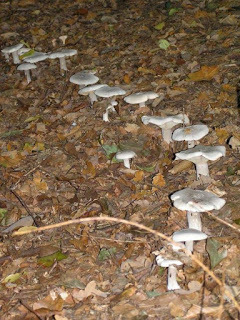
Clitocybe nebularis mushrooms in part of a ring. (CC BY-SA 3.0)
We in modern times may scoff at the traditional superstition of the fairy rings, but scientists still struggle to explain the so-called “fairy circles” occurring in Africa. It is reported that in Namibia in southern Africa, bare, circular spots on the sandy grasslands have been occurring for unknown reasons. The circles behave much like the mycelium growths, persisting and then vanishing after decades. But scientists have ruled out a similar fungus, and remain stumped as to why these rings have been appearing in the remote, arid landscape. Local oral tradition explain them as the work of spirits and nature gods.

The enigmatic rings of Africa can be about 6.5 feet (2 meters) to almost 40 feet (12 meters) in size. The circles appear, and then disappear, leaving “ghost circles” behind. Credit: Mike and Ann Scott of the Namib Rand Nature Reserve
The differences of the lush outside of the ring compared to the dead inside, with no obvious cause, undoubtedly led the people of antiquity to presume that otherworldly affairs were at work. Certainly the abrupt, unpredictable change in the natural world, the age-old circle symbolism, and the fact that these ‘portals’ seemed temporary and mobile were convincing evidence of the supernatural.
To the consternation and frustration of those now seeking unblemished lawns, ridding a yard of a fairy ring can be as tricky as dealing with the legendary fairy-folk. To stop the mycelium from spreading its necrosis, one should pick the mushrooms as soon as they appear. Next, a thorough soaking of water may drown out the problem, but often it requires digging down beneath the white fungus to remove the tainted soil. This can sometimes mean digging down several feet or more to get all the infected dirt, replacing it all with fresh soil, and restarting the lawn anew.
Perhaps it would be easier just to take your chances with the fairies.
Featured image: A mushroom ring creating a circle on the grass. These rings were believed to be portals to the fairy realm, and areas of danger. (Unukorno, Flickr/CC BY-SA 2.0)
By Liz Leafloor
Published on March 01, 2018 23:30
February 28, 2018
After 300: The Posthumous Vengeance of King Leonidas of Sparta
Ancient Origins
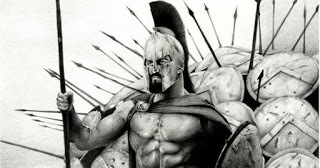
After 300: The Posthumous Vengeance of King Leonidas of Sparta
Mythologically descended from the hero Herakles, the Agiad dynasty of ancient Sparta reigned alongside the Eurypontids almost since the beginning of the city-state. When war was on the borders of their land, and that of their neighboring city-states, it was to the current Heraklean descendent that those city-states turned. Even the Athenians, who were long-time rivals of the Spartan warriors looked to the current Agiad king for guidance in the darkest time of the war. That king, unsurprisingly, was King Leonidas I. A
King Amongst Kings
The better remembered of the two warrior-kings of the ancient Greek city-state Sparta, King Leonidas I lived and ruled between the 6th and 5th centuries BC. His time on the throne was short-lived, but his legacy has lasted lifetimes. Leonidas is the king who many other kings aspire to emulate; King Leonidas gave everything to defend and protect his homeland. Called upon to lead the allied forces of the Greek city-states based on his military record alone, it is said that King Leonidas tried to protect his soldiers, ordering them to leave the battlefield to fight another day. They did not, as one might guess, as they were Spartans; one way or another, Spartans return from battle—either with their swords, or on them, as the saying goes. Leonidas' words of protection at the battle of Thermopylae fell on deaf ears, and the Greeks were slaughtered that fateful day in 480 BC

Leonidas at Thermopylae by Jacques-Louis David (Public Domain)
What happened after the massacre, however? What happened after the death of the one of the greatest military leaders? Without Leonidas, Sparta was down one king; it had been tradition for two kings to rule the city-state, one from each of the two primary families, the Agiads and the Eurypontids. With his death at the hands of the army of Xerxes, king of Persia, and his head paraded around on a spike, Sparta was left short-handed. What was the next step?
Revenge.
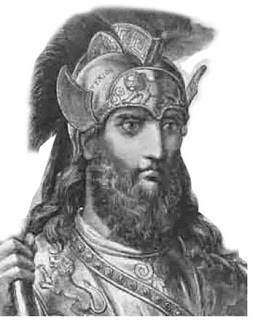
Leonidas I of Sparta (CC BY-SA 4.0)
Wrath of the Gods
If one believes in the ancient Greek gods—as the city-states clearly did—it is impossible not to see the vengeance those gods encouraged through their mortal soldiers following the death of Herakles' descendent. With the death of King Leonidas and the insult to his person, the Persians had essentially painted a bright red, divinely taunting target on their backs. Over the next year, the Persians and Greeks engaged in their final land and sea battles, of which the Persians suffered as often as not. Salamis and Plataea, two of the most decisive Greek victories, officially turned the tide in favor of the Greeks. In fact, a better vengeance could not have been written for King Leonidas. The Greeks, who had not forgotten the slaughter of Thermopylae, returned the favor in spades at the Battle of Plataea.

A romantic version painting of the Battle of Salamis by artist Wilhelm von Kaulbach. (Public Domain)
The ancient historian Herodotus (5th century BC) is one of the primary sources of this battle. Following a stalemate around the Persian camp constructed in Plataea, the Persians were unintentionally (though it was lucky for the Greeks) lulled into a sense of victory. Having cut off the Greeks from their supply lines, the Persians believed the few Greeks who retreated to regain those connections represented the whole army; the subsequent Persian attack quickly proved them wrong. The Greek allies literally had the high ground, and a defeat of those Persian forces, led by Mardonius, was relatively swift. The Greek forces then, loosely interpreted from ancient texts, exacted their revenge for the slaughter of Leonidas and his men by massacring the Persian camp at Plataea. Later that afternoon, the Greeks finished the job at the final battle of Mycale.
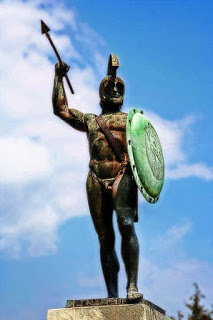
King Leonidas I Monument at Thermopyles. (CC BY-SA 3.0)
Exacting Revenge
One could attribute this "retribution" as constructed by King Leonidas' son Pleistarchus, intended to take the throne upon Leonidas' death. Yet in an interesting turn of events, Pleistarchus was too young to rule at his father's death, and the boy's guardian Pausanias, was actually on the second Spartan throne. Thus the decisive, somewhat brutal, actions against the Persians at Plataea and Mycale may or may not have been an act of vengeance in the name of the father Leonidas, but were almost certainly for the Herculean general who sacrificed everything for his home, and the homes of those allied with him. (One should remember that Sparta and Athens were only on good terms when they were teamed up against Persia. They placed their animosities aside during the Persian War, Athenians willingly following Spartans, and Spartans trusting to delegate to Athenians. This alliance would crumble soon after the war, but Leonidas' actions are even more inspiring for the prejudices put aside.)
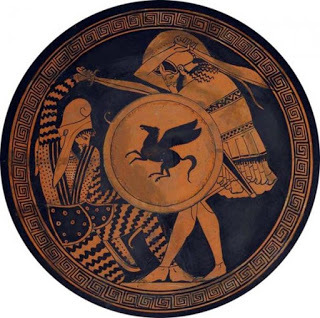
Greek and Persian warriors depicted fighting on an ancient kylix. 5th century BC. (Public Domain)
United States of Leonidas
King Leonidas' sacrifice might not have resulted in the battle to end all Persian-Greek battles, however it did inspire a great deal of "nationality", a concept not yet fully formed in the ancient world. Yet the Greek city-states saw a common enemy, and shared a common goal, and for a brief period of time, respected and valued the same man—homeland and culture aside. The increased sense of unity Leonidas inadvertently forged between the Spartans, Thebans, Athenians, etc. led to an increased determination; the Greeks left no man standing at Plataea and Mycale if they could find one. The victory of the Greeks over the Persians resonated for centuries, and Leonidas' name is remembered far better than those of the men who returned home with their shields rather than on them. Because of this (and the later cockiness of the Athenians), the Spartans and their allies successfully defeated the Athenians in the Peloponnesian War, the next great battle on their horizon.
Top image: King Leonidas by David Baldo (deviantart)
By Riley Winters

After 300: The Posthumous Vengeance of King Leonidas of Sparta
Mythologically descended from the hero Herakles, the Agiad dynasty of ancient Sparta reigned alongside the Eurypontids almost since the beginning of the city-state. When war was on the borders of their land, and that of their neighboring city-states, it was to the current Heraklean descendent that those city-states turned. Even the Athenians, who were long-time rivals of the Spartan warriors looked to the current Agiad king for guidance in the darkest time of the war. That king, unsurprisingly, was King Leonidas I. A
King Amongst Kings
The better remembered of the two warrior-kings of the ancient Greek city-state Sparta, King Leonidas I lived and ruled between the 6th and 5th centuries BC. His time on the throne was short-lived, but his legacy has lasted lifetimes. Leonidas is the king who many other kings aspire to emulate; King Leonidas gave everything to defend and protect his homeland. Called upon to lead the allied forces of the Greek city-states based on his military record alone, it is said that King Leonidas tried to protect his soldiers, ordering them to leave the battlefield to fight another day. They did not, as one might guess, as they were Spartans; one way or another, Spartans return from battle—either with their swords, or on them, as the saying goes. Leonidas' words of protection at the battle of Thermopylae fell on deaf ears, and the Greeks were slaughtered that fateful day in 480 BC

Leonidas at Thermopylae by Jacques-Louis David (Public Domain)
What happened after the massacre, however? What happened after the death of the one of the greatest military leaders? Without Leonidas, Sparta was down one king; it had been tradition for two kings to rule the city-state, one from each of the two primary families, the Agiads and the Eurypontids. With his death at the hands of the army of Xerxes, king of Persia, and his head paraded around on a spike, Sparta was left short-handed. What was the next step?
Revenge.

Leonidas I of Sparta (CC BY-SA 4.0)
Wrath of the Gods
If one believes in the ancient Greek gods—as the city-states clearly did—it is impossible not to see the vengeance those gods encouraged through their mortal soldiers following the death of Herakles' descendent. With the death of King Leonidas and the insult to his person, the Persians had essentially painted a bright red, divinely taunting target on their backs. Over the next year, the Persians and Greeks engaged in their final land and sea battles, of which the Persians suffered as often as not. Salamis and Plataea, two of the most decisive Greek victories, officially turned the tide in favor of the Greeks. In fact, a better vengeance could not have been written for King Leonidas. The Greeks, who had not forgotten the slaughter of Thermopylae, returned the favor in spades at the Battle of Plataea.

A romantic version painting of the Battle of Salamis by artist Wilhelm von Kaulbach. (Public Domain)
The ancient historian Herodotus (5th century BC) is one of the primary sources of this battle. Following a stalemate around the Persian camp constructed in Plataea, the Persians were unintentionally (though it was lucky for the Greeks) lulled into a sense of victory. Having cut off the Greeks from their supply lines, the Persians believed the few Greeks who retreated to regain those connections represented the whole army; the subsequent Persian attack quickly proved them wrong. The Greek allies literally had the high ground, and a defeat of those Persian forces, led by Mardonius, was relatively swift. The Greek forces then, loosely interpreted from ancient texts, exacted their revenge for the slaughter of Leonidas and his men by massacring the Persian camp at Plataea. Later that afternoon, the Greeks finished the job at the final battle of Mycale.

King Leonidas I Monument at Thermopyles. (CC BY-SA 3.0)
Exacting Revenge
One could attribute this "retribution" as constructed by King Leonidas' son Pleistarchus, intended to take the throne upon Leonidas' death. Yet in an interesting turn of events, Pleistarchus was too young to rule at his father's death, and the boy's guardian Pausanias, was actually on the second Spartan throne. Thus the decisive, somewhat brutal, actions against the Persians at Plataea and Mycale may or may not have been an act of vengeance in the name of the father Leonidas, but were almost certainly for the Herculean general who sacrificed everything for his home, and the homes of those allied with him. (One should remember that Sparta and Athens were only on good terms when they were teamed up against Persia. They placed their animosities aside during the Persian War, Athenians willingly following Spartans, and Spartans trusting to delegate to Athenians. This alliance would crumble soon after the war, but Leonidas' actions are even more inspiring for the prejudices put aside.)

Greek and Persian warriors depicted fighting on an ancient kylix. 5th century BC. (Public Domain)
United States of Leonidas
King Leonidas' sacrifice might not have resulted in the battle to end all Persian-Greek battles, however it did inspire a great deal of "nationality", a concept not yet fully formed in the ancient world. Yet the Greek city-states saw a common enemy, and shared a common goal, and for a brief period of time, respected and valued the same man—homeland and culture aside. The increased sense of unity Leonidas inadvertently forged between the Spartans, Thebans, Athenians, etc. led to an increased determination; the Greeks left no man standing at Plataea and Mycale if they could find one. The victory of the Greeks over the Persians resonated for centuries, and Leonidas' name is remembered far better than those of the men who returned home with their shields rather than on them. Because of this (and the later cockiness of the Athenians), the Spartans and their allies successfully defeated the Athenians in the Peloponnesian War, the next great battle on their horizon.
Top image: King Leonidas by David Baldo (deviantart)
By Riley Winters
Published on February 28, 2018 23:30
Heavy Hitters: 2,000-Year-Old Boxing Gloves Suggest Roman Soldiers Used to Duke It Out
Ancient Origins

Still molded to the form of their former owner’s knuckles, boxing gloves found at the Roman site of Vindolanda in Northumberland, England hint at tales of soldiers increasing their battle skills, keeping up their fitness, and passing the time gambling on fights while stationed in the far northern lands of the empire.
The summer of 2017 was a remarkable one for Vindolanda archaeologists. While exploring the ruins of the Roman site near Hadrian’s wall they unearthed a wealth of artifacts – from the thin wooden Vindolanda Writing Tablets covered in cursive script to swords, shoes, and dice, excavators had a uniquely amazing year. But one specific find was the undisputed champion– a pair of one of a kind boxing gloves that have rolled with the punches of time.
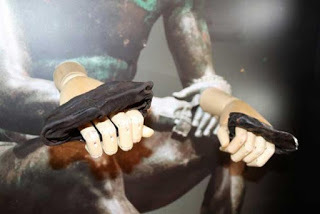
these are leather boxing gloves from the Roman period. (Vindolanda Trust)
The boxing gloves are not only noteworthy for outstanding preservation, but Vindolanda Trust reports they are an extremely rare discovery. A press release on the Roman artifacts states, “Research of the objects at Vindolanda along with the considered observations by Roman leather and other experts has indicated that these leather objects are in fact boxing gloves and probably the only known surviving examples from the Roman period.”
According to ChronicleLive, the two gloves were found in a location identified as the cavalry barracks of the Vindolanda fort. The boxing gloves date to approximately 120 AD and are a testament to sparring matches which probably took place amongst members of the garrison. Patricia Birley, former director of the Vindolanda Trust who is now focused on conservation and research at the site, told ChronicleLive, “Boxing is an ancient sport and it was practised in the Roman army as a keep fit exercise and probably in combat contests between units, rather like the way the modern army still has its tournaments.”

The boxing gloves on display in the museum. (Vindolanda Trust)
Thus, the boxing gloves demonstrate some general habits amongst Roman soldiers, but they also have a personal touch. Birley explained,
“Items like the gloves are a very personal link to the Romans at Vindolanda. You can still put your hands into the gloves and can see where the knuckles of the owner have moulded into the leather […] The larger one has been patched and repaired but has been kept probably because the owner valued it.”
Vindolanda Trust reports that the gloves are not a matched pair and although they were skillfully made they were probably not meant for “professional” boxing matches. Most likely the gloves served more as a protective guard for the knuckles of their wearer. The larger glove was made from one piece of leather folded and filled with a natural material which acted as a shock absorber. The smaller glove was made in a similar fashion but filled with hard twisted leather instead.
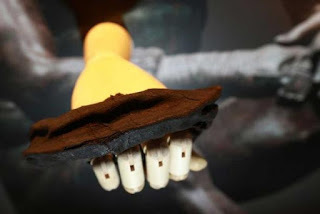
Detail of one of the Roman boxing gloves found at Vindolanda. (Newcastle Chronicle)
BBC News reports of the impact the boxing gloves had on Dr. Andrew Birley, Vindolanda Trust director of excavations. Dr. Birley said,
"I have seen representations of Roman boxing gloves depicted on bronze statues, paintings and sculptures, but to have the privilege of finding two real leather examples is exceptionally special. The hairs stand up on the back of your neck when you realise you have discovered something as astonishing as these boxing gloves."
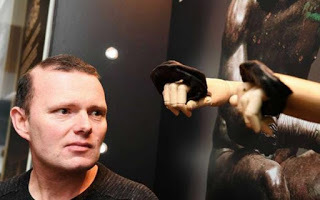
Vindolanda Trust’s CEO, Dr. Andrew Birley next to the Roman boxing gloves on display at the museum. (Hexham Courant)
The boxing gloves may be knockout artifacts these days, but they are just one of about 20,000 leather items that have been found at Vindolanda. 8,000 of the leather items are shoes.
Other noteworthy finds from last season’s work include horse gear, complete swords, writing tablets, combs, and dice. Some of these artifacts will undoubtedly join others in the Vindolanda museum. ChronicleLive says that the new excavation season is set to begin in the first week of April.
Top Image: The first ever Roman boxing gloves found in Britain are now on display at Vindolanda. Source: Coventry Telegraph
By Alicia McDermott
Published on February 28, 2018 00:00
February 26, 2018
Book Review - Planetary Wars: Rise of an Empire by Mary Ann Bernal

R.B.
5.0 out of 5 stars
Science fiction at it's finest!
February 15, 2018
Format: Kindle Edition|Verified Purchase
Planetary Wars Rise of an Empire by Mary Ann Bernal is a suspenseful ride into the unknown. A place none of us have ever been to or would be able to experience in our lifetime. That is what makes this fantasy so irresistible. The story reads true to life but is more exciting and powerfully exhilarating. It’s a dark tale of lies and destruction. The drama continues throughout and I got caught up in a web of deceit.
There is an old fashion quality to this tale. If you are a Star Trek fan I imagine you will appreciate the non-stop misadventures into unchartered territory.
The author writes a compelling story that pulled me in right away and made me feel as if the characters were real, though of course, from another planet. Such a nice escape!
“The whirlwind romance contributed to Anastasia’s inner turmoil. She usually had a good grip on her emotions, but with Jayden, she was no longer disciplined. Every rational thought was discarded while her heart ruled.”
The romantic exchange makes this more than just a fantasy. So much more. The heart wants what the heart wants. And at all costs, so it seems.
Click for purchase information
Published on February 26, 2018 23:30



